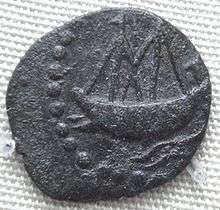Vasishthiputra Pulumavi
| Vasishthiputra Pulumavi | |
|---|---|
 Indian ship on lead coin of Vasishthiputra Pulumavi | |
| Satavahana King | |
| Reign | 2nd century CE |
| Predecessor | Gautamiputra Satakarni |
| Successor | Vashishtiputra Satakarni |
| Dynasty | Satavahana |
| Father | Gautamiputra Satakarni |
| Satavahana Kings (271 BCE – 220 CE) | |
| Simuka | (1st century BCE) |
| Kanha | (1st century BCE/CE) |
| Satakarni | (1st-2nd century CE) |
| Sivasvati | (1st century CE) |
| Gautamiputra Satakarni | (1st-2nd century CE) |
| Vasishthiputra Pulumavi | (2nd century CE) |
| Vashishtiputra Satakarni | (2nd century CE) |
| Shivaskanda Satakarni | (2nd century CE) |
| Yajna Sri Satakarni | (2nd century CE) |
| Vijaya | (2nd century CE) |
Vasishthiputra Pulumavi (IAST: Vāsiṣṭhiputra Śrī Pulumāvi) was a Satavahana king, and the son of Gautamiputra Satakarni.[1] His reign is dated variously: 110–138 CE[2] or 130–159 CE.[3] He is also referred to as Vasishthiputra Sri Pulumavi. Ptolemy, the second century writer, refers to Pulumavi as Siriptolemaios, a contemporary of the Western satrap, Chastana.[4]
Some of the lead coins of Pulumavi depict two-masted Indian ships, a testimony to the seafaring and trading capabilities of the Satavahanas during the 1st-2nd century CE. During his rule, Gautami Balasri, the mother of Gautamiputra Satakarni, laid an inscription at Nashik. Pulumavi was succeeded by his younger brother Vashishtiputra Satakarni.
References
- ↑ Singh, Upinder (2008). A history of ancient and early medieval India : from the Stone Age to the 12th century. New Delhi: Pearson Education. p. 381. ISBN 9788131711200. Retrieved 11 April 2016.
- ↑ Carla M. Sinopoli (2001). "On the edge of empire: form and substance in the Satavahana dynasty". In Susan E. Alcock. Empires: Perspectives from Archaeology and History. Cambridge University Press. p. 166-168.
- ↑ Susan L. Huntington (1 January 1984). The "Pāla-Sena" Schools of Sculpture. Brill Archive. p. 175. ISBN 90-04-06856-2.
- ↑ "According to Ptolemy, Siriptolemaios (Sri Pulumayi), son of Gautamiputra Satakarni, continued to reign at Paithan (Pratisthana), while Ozene (Ujjain) fell into the hands of Tiasthenes (Chastana)." Alain Danielou, A Brief History of India (Inner Traditions, 2003), mentioned here
| Preceded by Gautamiputra Satakarni |
Satavahana ruler 2nd century CE |
Succeeded by Vashishtiputra Satakarni |
This article is issued from Wikipedia - version of the 11/4/2016. The text is available under the Creative Commons Attribution/Share Alike but additional terms may apply for the media files.